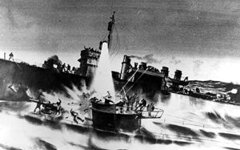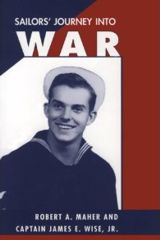

Bow-on-bow — Borie’s last battle in the mid-Atlantic was one of the most dramatic destroyer-vs.-U-boat actions of World War II.

Launched 4 October 1919 by Philadelphia’s William Cramp and Sons Ship and Engine Building Co., the first Borie was sponsored by Miss Patty Borie, great-grandniece of Secretary Borie; and commissioned 24 March 1920 with Lieutenant Commander E. F. Clement in command.
In April 1920, Borie joined the United States Naval Detachment in Turkish waters for service in the Black Sea. The following year she reported to Destroyer Division 38, Asiatic Fleet, and for the next four years alternated between the Philippine Islands during winter and Chefoo and Shanghai, China during summer. She then returned home and patrolled in the Caribbean until the spring of 1927 when she made a cruise to Europe. Borie remained with the Atlantic Fleet until 1929 when she began another three-year tour with the Asiatic Fleet.
Following conversion as a squadron leader at San Diego (1932–33) she joined Destroyer Squadron 2, Battle Force. She remained in the Pacific on normal destroyer duty until late 1939 and then transited the Panama Canal to join the Neutrality Patrol. Attached to the 15th Naval District there, she operated with the Inshore Patrol, guarding both Atlantic and Pacific approaches to the canal. In December 1941, in the face of the growing U-boats blitz of the Caribbean, she replaced Goff (DD 247) as flagship of Destroyer Division 67, which also included Tattnall (DD 125) and Barry (DD 248). On 15 June 1942, she rescued survivors of USAT Merrimac, which had been torpedoed.
 A Sailor’s Journey into War by Borie shipmate Robert A. Maher and Capt. James E. Wise, Jr., USN (Ret.).
A Sailor’s Journey into War by Borie shipmate Robert A. Maher and Capt. James E. Wise, Jr., USN (Ret.).
After returning to Philadelphia in November 1942, Borie went to New Orleans for an overhaul and then was reassigned to the South Atlantic. For three months beginning in February 1943, she, Barry and Goff were attached to Escort Unit 23.2.4 with gunboats Courage (PG-70) and Tenacity (PG-71) and patrol craft PC-575 and PC-592, which operated between Trinidad and Recife, Brazil with Admiral Jonas Ingram’s South Atlantic Fleet (later Fourth Fleet). Returning to Norfolk in May, the three destroyers escorted a convoy to Casablanca, French Morocco and on their return were assigned to hunter-killer Task Unit 21.14, escorting Card (CVE-11) under her Capt. Arnold J. Isbell, with Borie under Lt. Charles Hutchins, then the US Navy’s youngest destroyer commander.
On 27 July, the Card task group cleared Norfolk for the first of two offensive patrols, during which it sank eight submarines and was awarded the Presidential Unit Citation for the period ending 25 October. A ninth sinking, however, was Borie’s last action.
Shortly after 2000 on 31 October, while en route back to the United States from Casablanca and detached from Card’s screen to search for two submarines spotted by planes, Borie obtained radar contact on U-256 and closed to ram. The sub promptly dove. Two depth charge attacks forced it back to the surface but it submerged again, stern first, and after a third attack, a large oil slick was observed. Though U-256 made it home, Capt. Hutchins believed Borie had achieved a kill and reported, “Scratch one pig boat; am searching for more.”
Shortly before 0200 on 1 November, radar contact was obtained on U-405, which submerged. After a depth charge attack, U-405 surfaced again in gale-force winds and rising seas, apparently unable to submerge. The ensuing surface battle lasted an hour and four minutes as Borie fixed her searchlight on the target and both ships opened fire. For about 20 minutes, Capt. Hutchins circled at 25 knots, frustrated by veteran Korvettenkapitän Rolf-Heinrich Hopmann’s shiphandling skill and his U-boat’s smaller turning radius. An early 4-inch salvo from Borie blew away its deck gun and 20mm fire kept its crew from manning their machine guns. Eventually, Borie found an opening and closed the sub’s starboard quarter to ram. At the moment of impact, however, with U-405 turning hard to port, a wave lifted Borie’s bow onto its foredeck, pinning it below and locking the ships together only 25–30 degrees from parallel.
Utilizing every weapon including small arms, a sheath knife and an empty 4-inch shell case, Borie’s crew maintained “murderous” fire against U-405 and its crew as the action of the seas worked the two ships together, crushing and holing Borie’s port side below the waterline.
This standoff continued for ten long minutes before the ships separated; then Borie resumed the chase and gunnery attack and launching a single torpedo, which missed. Resorting to trickery—dousing her searchlight, tracking by radar to close and then steering with engines to kick her stern in close as the sub attempted to ram—Borie next fired a full salvo from her starboard depth charge projectors. Three charges set to detonate at a depth of 30 feet perfectly straddled U-405’s conning tower and exploded, arresting its momentum. Under way again, Borie fired another torpedo that missed but her continuing gunfire eventually scored a decisive hit on the submarine’s diesel exhaust. In surrender, U-405 began firing Very’s stars and crewmembers abandoned ship into rubber rafts. When sub sank by the stern and exploded, Capt. Hutchins later wrote, “a yell went up from all hands that probably could be heard in Berlin.”
Maneuvering in the heavy seas, Borie approached the survivors off her port bow. She was near enough for their faces to be visible when an answering white star appeared beyond them; immediately her sound operator reported a torpedo on the same bearing. With no alternative, Borie went ahead with all available speed and came hard left to evade. Sadly, in so doing she ran directly over the rafts as the torpedo passed down her port side; they were not seen again.
As dawn broke, Borie’s own situation had become desperate. Now in 20-foot seas and dense fog, her forward engine room was flooded completely, only her starboard engine was operating and power was failing with all fuel needed to operate pumps. With many U-boats reported in the vicinity, her position was unknown and she was unable to contact Card. After 21 sleepless hours, her weary crew formed bucket brigades; yet she continued to settle. Fearing capsize, Capt. Hutchins ordered all possible topweight jettisoned; even her gun director.
At 1100, the communications officer succeeded in restarting her emergency radio generator with lighter fluid and torpedo alcohol. Card soon received the message “commenced sinking” and with her escorts, altered course to close Borie’s position. TBF carrier planes found her and at noon, Goff came alongside in an attempt to help her dewater and then take her in tow, but to no avail.
At 1630, with bad weather and darkness closing in, still no power and a probability of sinking during the night, Lt. Hutchins at last ordered “abandon ship.” The exhausted crew took to rafts, well knowing the slim odds of survival in the 40-degree water. While Card, unescorted, steamed within ten miles, Goff succeeded in taking aboard seven officers and 99 men; Barry another officer and 22 men, but 27 shipmates were knocked unconscious or drowned in the effort.
Still, Borie did not sink during this second night: wallowing in subsiding seas, she remained afloat on the morning of 2 November. As Card needed her anti-submarine screen back on station, however, it was decided not to attempt to tow Borie but to sink her. After torpedoes from Barry and Goff missed and 4-inch fire proved ineffective, bombs from Card aircraft finally put her under.
In addition to her Presidential Unit Citation as part of the Card task group, Borie earned four service stars for operations in World War II.
A second USS Borie, Allen M. Sumner-class DD 704 was launched 4 July 1944, commissioned 21 September, and served with distinction at Iwo Jima and Okinawa before sustaining a hit from a suicide aircraft off Japan, 9 August 1945, one of the last destroyers damaged in World War II.
Sources: Action report, Maher and Wise, DANFS, Roscoe.